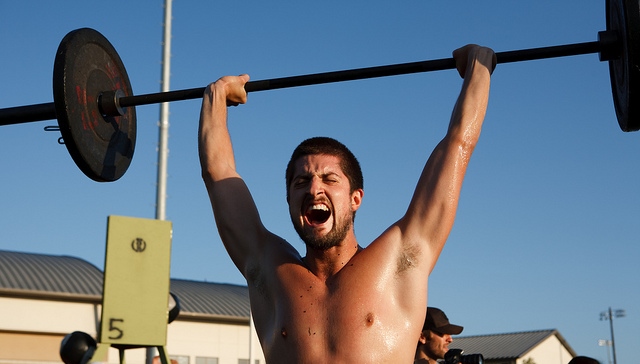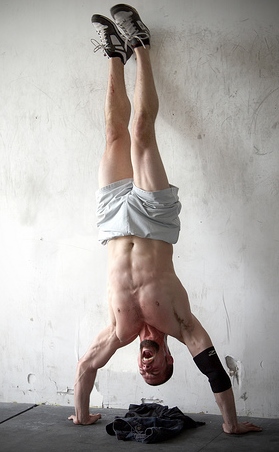The claims are bold: run less mileage with more intensity (and a lot of lifting) to race faster. But does it work?

That’s the million dollar question. Is CrossFit Endurance (CFE) an effective training program for runners?
Here’s how CFE describes itself:
CrossFit Endurance is an endurance sports training program dedicated to improving performance, fitness and endurance sports potential. We inspire, coach, and provide our community with the most aggressive and proven fundamentals of sports science, exercise physiology, nutrition, and athletic training protocols.
Power and speed are critical components to success in the endurance world… We focus on eliminating unnecessary volume of training while increasing intensity. Our programming is structured, sport-specific and seamlessly integrated with Olympic lifts, powerlifting, gymnastics movements, explosive activity and mobility-based support…
Our strength and conditioning approach for endurance athletes is unparalleled. We incorporate the CrossFit fundamentals of being constantly varied. Repetition is the enemy and results in a decreased ability to build fitness.
Extraordinary claims require extraordinary evidence. And we’ll get to that soon…
I want to share my thoughts on CrossFit (CF) so you have a framework for evaluating any new training program. It would be easy for me to record a short video listing the reasons why I dislike CF, but I want to do deeper.
It’s become increasingly popular among runners as a way to cross-train and increase strength. Before it’s proven itself as an effective training protocol, flocks of runners have tried to use it to become better runners, prevent injuries, or get stronger.
And that leaves the question: does CrossFit help runners? And is CrossFit Endurance an effective way to train runners?
I say no to both. Here’s why.
Strike 1: Specificity!
The most damning element of CFE is that it violates the rule of specificity, which simply says that to be a good runner you have to practice running. To run well in any event you have to prioritize race-specific fitness. Training, therefore, develops the tools you’ll need on race day.
This is physiology and training theory 101. It doesn’t get more basic than this.
To be a good power lifter, you have to practice power lifting.
To be a good marathoner, you have to practice running long distances.
CrossFit Endurance reminds me of this fun quote:
You can’t plant potatoes and expect to harvest carrots.
Simple, isn’t it? I wrote a training program for a woman who took three months off from running and was surprised that she felt so bad when she started running again because she spent every day on the elliptical.
The elliptical is not interchangeable with running. This runner was planting potatoes and expecting to harvest carrots.
Likewise, throwing long runs and marathon-specific workouts in the trash in favor of nonsensical “endurance workouts” that favor upper body lifting and intervals run until “form deteriorates” is insane.
So much for train, don’t strain.
Strike 2: “Proven” Fundamentals of Sports Science?
CrossFit Endurance is essentially a combination of circuit-based workouts where you lift heavy, often as fast as possible. They’re called “AMRAP” (As Many Reps As Possible) workouts and are based on time.
An example:
3 rounds for time of: 25 kettlebell swings and 25 burpees
These workouts are incredibly intense. They’re then combined with HIIT (high-intensity interval training), also known as Tabata Sprints.
One such workout is 8 reps of 20 second sprints as fast as you can go with a mere 10 second recovery.
Combine high-intensity lifting with high-intensity running and what do you get? Probably an over-trained or injured runner! See my earlier post that discusses over-training and the “chronic cardio” debate.
Ultimately, CFE ignores the history of training. See, we’ve already tried the interval-only approach. It was how Roger Bannister trained when he became the first person in history to run a mile in less than four minutes.
But it’s not optimal for long-term success and there are more effective ways to train (which is why the Mile world record is now a staggering 3:43:13).
There’s a sweet spot of easy running and intensity. Without both, your results will be sub-par.
But CrossFit Endurance relies on Tabata sprints and intense circuit workouts to produce endurance runners. And their reliance on the science behind these workouts is mistaken because they confuse VO2 Max with performance.
That’s because Tabata sprints DO increase VO2 Max (the maximum amount of oxygen your body can deliver to working muscles). But to then conclude that an increase in VO2 Max will lead to faster race results is incorrect – they’re two very different things.
I highly recommend Steve Magness’ more thorough discussion of the science behind CFE workouts, aptly titled CrossFit Endurance, Tabata Sprints, and Why People Just Don’t Get It.
I trust Steve because he’s a 4:01 miler who coached elites like Galen Rupp and Mo Farah under Alberto Salazar at the Nike Oregon Project. He has a master’s in exercise science, coaches a few pro runners, and is now the head cross country coach at the University of Houston.
Strike 3: Who Needs Well-Rounded Athleticism?
There are five fitness traits that define athleticism: Strength, Speed, Endurance, Flexibility, and Coordination according to Tudor Bompa, the “father of periodization theory,” an Olympic rower, coach of multiple Olympic and World Championship medalists, and Professor Emeritus at York University.
Unfortunately, CrossFit Endurance only prioritizes speed and power (and misunderstands that power is simply the combination of strength and speed).
Every aspect of athleticism – or biomotor abilities – must be present in a good distance runner. This concept of “multi-lateral training” focuses on the development of every component of fitness in planned balance. That’s why Dathan Ritzenhein skips, runs, and does power cleans.
Specialization is ultimately necessary depending on your focus (i.e., specificity!), but long-term progress demands balance.
USA Track & Field says:
“The biomotor abilities are requisite to each other and are interdependent upon each other. While specialization is necessary and appropriate at times, the value of balance among an athlete’s biomotor qualities and balanced development of these abilities in the program should not be underestimated.”
So why ignore endurance if your goal is to specialize in endurance? True, there are other ways to boost endurance, but they’re not as effective (read Steve Magness’ article linked to above).
Ignoring the best way to build endurance in an endurace-focused program is a blunder I can’t understand.
Strike 4: It’s Not Ideal for Building Strength
This is one of my favorites. So the whole goal of CFE is to lift heavy to build strength – to increase the structural integrity of the “chassis” to prevent injuries.
But circuit-workouts for time are not the best way to increase strength!
In Anatomy for Runners by Jay Dicharry, he outlines how you lift for power, strength, and endurance:
Power: 2-5 reps as fast as possible for 3-6 sets.
Strength: 5-8 reps for 2-4 sets. The speed of the movement isn’t as important.
Endurance: 12-28 reps done slowly for 1-3 sets.
So CFE is (kind of) lifting for power – when endurance running is not a power sport! Nor is true power required that much in any endurance event.
Without resting in between sets the strength gains are not maximized and you miss out on the whole reason why you should be lifting in the first place. If you don’t rest, you won’t get as strong.
Plus, there is no progression in the strength workouts in CrossFit Endurance (and we know the power of progression). There’s a random mix of some strength-oriented lifting with a lot of high-intensity AMRAP workouts.
Instead, runners need to lift for strength in the gym – with proper rest. But gym workouts with weights aren’t even necessary. Instead, runner-specific strength work can be done with body-weight exercises like those in the Strength Training for Runners program (highly recommended).
Strike 5: Personalization? Just do what I say!
Every runner is unique and needs a different combination of mileage, recovery, cross-training, injury prevention work, long runs, and workouts.
That’s why stock training plans often lead runners to plateau or get hurt – they’re made for everyone, not you.
With CrossFit Endurance, you have a giant stock training plan even down to the amount of weight you lift. Nothing is tailored.
There are WOD’s (Workout of the Day) that show you what to do, but doesn’t take into account where you are in the training cycle, who you are as a runner, and what your background is with the sport.
With no ability to modify the workouts, runners will get hurt, plateau, or not see as much progress. The results from custom training speak for themselves.
Strike 6: The Proof is in the Pudding
How many elite runners use a CrossFit strength program?
How many elite runners use CrossFit Endurance as their training program?
If CFE is “unparalleled” then how many CFE athletes are winning major road or track races?
The answer, of course, to all three of these questions is zero.
As self-pronounced “leaders in strength and conditioning for endurance athletes,” they should be ahead of the rest of the strength and conditioning world. So that begs the question, “what elite endurance athletes (those that compete at the professional level in any endurance sport) use CrossFit Endurance?”
To answer that question, I reached out to Alex Hutchinson, the author of Which Comes First, Cardio or Weights? To the best of his knowledge, he knows no professional or elite runners that use CrossFit Endurance.
Elite athletes are using the best training possible provided by the smartest coaches, physical therapists, and sports scientists in the world.
If CFE worked, they’d be first adopters. So much for forging “elite” fitness.
So, How Should Runners Train?
Runners need to go back to basics and focus on the fundamentals of sound training.
Increase your mileage and run a consistent long run to develop endurance.
Do consistent runner-specific core and strength exercises to stay healthy.
Run strides and hill sprints to work on your turnover and stride power.
Integrate race-specific workouts depending on your goals that follow a logical progression.
Periodize your training so you’re focused on different goals at different times: base-building, race-specific fitness, tapering/sharpening, or recovery.
Any other training program for runners ignores the basic science of adaptation, periodization, and specificity.
Read any good book about running and you won’t see a single mention of CrossFit Endurance – for good reason.
This is Part 1 of a 2-part series. Read the second installment about CrossFit here.